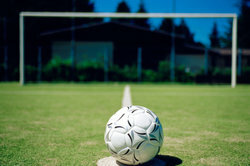Playing soccer after a cruciate ligament rupture
Whether as a recreational kicker or as a professional footballer - a cruciate ligament rupture is a serious injury not only results in a break of several months, but also a lengthy rehab and a lot of patience Patient. The way to a comeback is long and there are a few things to consider before playing football again.

What you need:
- patience
- Perseverance
A cruciate ligament rupture in soccer - worth knowing about cause, diagnosis and therapy
A cruciate ligament rupture happens at the moment Football very quickly, often not even a foul is the cause of this serious knee injury. A long break from sporting activities is the result, and the therapy lasts just as long until the knee is restored to the point where the patient can play football again.
- A cruciate ligament tear seldom occurs alone; it is usually a complex injury pattern that can affect both the menisci and the inner and outer ligaments.
- The diagnosis can usually be made very quickly, even on the pitch when playing football. A cruciate ligament rupture makes the knee very unstable, and a doctor can identify the injury in just a few simple steps. In the hospital, further examinations to clarify the diagnosis are possible, including magnetic resonance imaging and arthroscopy.
- A cruciate ligament rupture must be treated in any case, otherwise consequential damage such as cartilage detachment can occur due to the improper loading as a result of the instability. Torn cruciate ligaments never heal on their own.
- Conservative treatment includes intensive physiotherapeutic treatment in order to restore the lack of stability in the knee through targeted muscle building.
- During surgical treatment, the cruciate ligament is sutured and, if necessary, reinforced with the body's own tissue in order to prevent further tears. Physiotherapy follows the operation.
Cruciate ligament strain is a common knee injury. She occurs z. B. at …
Back on the field after the cruciate ligament rupture
The time has come - after your cruciate ligament rupture, you finally want to play football again and fight for points and goals with your teammates. However, the way here is long and arduous and in order not to directly injure yourself again, there are a few things that you should be aware of.
- Do not rush into anything and plan your return to the game and training operations meticulously with your doctor, therapist and trainer. It will do no good if you rush to start playing soccer again and your knee reacts immediately.
- Start with light running training and only increase the intensity as your knee allows. Listen to your body and stop immediately if your knee hurts or swells.
- After the running training, the first thing on the program is work with the ball. Coordination exercises, slalom and shooting exercises are the right means to get a feel for the round leather again. Again, always watch your knee to see if it reacts. Remember, you've had a ruptured cruciate ligament, the worst knee injury that can afflict you in football.
- The big moment has come - you are now starting team training and completing it together Your teammates not only run and ball exercises, but also the first Training games. The fun will only come with time, the excitement and fear are still pervasive at first and you have to regain your self-confidence little by little.
- Before you get back into the game, your coach will take you all over during the training sessions have observed carefully and give you time and again signs when you can expect the first missions to have. Don't rush into anything - you have had to wait a few months for this moment and you should be happy about every minute that you can play football again.
How helpful do you find this article?


